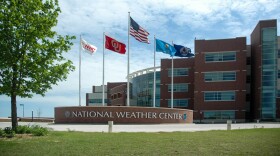The Myriad Botanical Gardens in downtown Oklahoma City is bustling with activity on a sunny day as people push strollers, walk dogs and feed the ducks. It’s a gorgeous Wednesday afternoon right now, but it’s springtime in Oklahoma, so the weather can change at any time.
“When it starts raining, is when I start looking at the messages,” Devonte Thibodeax said as walked along the garden’s waterway with Michaela Schweiger.
“If my iPhone does those alerts, where it goes off, that’s when we know something is actually happening,” Schweiger said.
Oklahomans know severe weather - especially tornadoes. Like many people, Thibodeaux and Schweiger use a lot of sources - mainly iPhone alerts, TV and social media. Brieana McPherson knows the forecast is severe if she sees it on Instagram.
“When people post pictures with captions or text over it, ‘Everybody go park their car in a garage’ or something like that,” McPherson said.
The science of meteorology has evolved with new technology that allows forecasters to predict severe weather several days in advance. For Oklahomans, that means more accurate and longer-term forecasts - often straight to their smartphones or through Facebook and Twitter. But effectively communicating severe weather threats remains elusive.
Rick Smith, the warning coordination meteorologist with the National Weather Service in Norman, said conveying that message is more complicated now that it’s ever been.
“On one hand, it’s good that we have so many different ways to get information to people,” Smith said. “On the other hand, there are so many different sources of information that people have, and there are all sorts of things that happen to information when it’s floating around out in the weather cloud.”
Messages change as they are passed from one person to the next, either through Twitter or simple conversation. Smith said uncertainty terms like “possible,” “maybe” and “potential” are lost, and the message morphs into a warning about a “definite” tornado or severe weather outbreak. With social media, it’s like a game of telephone.
“The more hands, so to speak, that this information is going through, the higher the potential for things to get dropped, things to get changed, nuances to not be picked up that if you were communicating directly,” Smith said.
Julie Demuth researches meteorology and communication at the National Center for Atmospheric Research in Boulder, Colorado and agrees that social media increases the chance for distorted information. But at the same time, it gets weather forecasts to more people.
“People don't just get one piece of information and then make a decision about what to do,” Demuth said. “They are going to be evaluating their risk as that threat evolves. So when we put out increasingly specific information as that threat evolves and it goes out via multiple channels it gives people an opportunity to access it to make sense of it, to personalize it, to share it with other people.”
And those first details about potential weather threats often come out several days in advance.
In April, the Storm Prediction Center forecast a storm nearly a week ahead of time, calling for rain, hail and the potential for tornadoes in Oklahoma. The rain and hail came, but large tornadoes never materialized near cities or towns.
“One of the things that we really really don't know about how people respond to extreme information is what the impact of false alarms are,” said Harold Brooks, a scientist at the National Oceanic and Atmospheric Administration’s National Severe Storms Laboratory.
Brooks doesn’t think there is much evidence for this in tornado warnings that come 15 to 30 minutes ahead of a storm. But he said scientists don’t know how false alarms from longer-range forecasts influence decision-making. That could lead to a “crying wolf” effect.
“We have to find a way to figure out and come up with some way to identify best practices so that we can you know we can hopefully impact people's behavior in a positive way,” Brooks said.
Demuth said social scientists can’t study people one time and have everything figured out. Humans and technology change.
“We're talking today about social media or Twitter and we wouldn’t even if thought to talk about this 10 years ago and so all those questions become different when technology and people and and even improved meteorological information is out there and is changing the whole landscape,” Demuth said.
She said studying how people respond is kind of like studying the weather - you can’t study one tornado and understand everything there is to know about them.
KGOU is a community-supported news organization and relies on contributions from readers and listeners to fulfill its mission of public service to Oklahoma and beyond. Donate online, or by contacting our Membership department.








